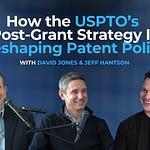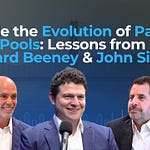“Gradually, then suddenly.” – Hemingway, The Sun Also Rises
That line kept running through my head as I thought about everything that’s happened since the last season of Clause 8 wrapped up on April 8, 2025.
Before releasing the first episode of the new Clause 8 season, I wanted to take a step back and catch up on the major shifts that have taken place — at the USPTO, in IP policy, and across the patent community.
I’m especially excited to share that this season is being recorded in our brand-new Clause 8 studio and released in audio and video. We’ll also be sharing special content on YouTube that won’t appear anywhere else. If you subscribe, it not only helps us expand our reach but also ensures you don’t miss any of it. I’d really appreciate your support.
What’s happened since April
When Coke Morgan Stewart was chosen as USPTO’s acting director, I expected her to bring the PTAB back in line. But the speed and decisiveness of her actions has still been striking. Almost overnight, Stewart reined in PTAB’s role in invalidating patents and pushed forward a range of other priorities.
By contrast, progress on improving patent examination and decreasing the backlog has been more modest.
And outside the USPTO, the administration’s approach to IP rights has been more complicated, with developments that sometimes undercut the USPTO’s pro-patent trajectory. The choice of John Squires as permanent director adds another layer of opportunity and uncertainty.
PTAB Shift
Post-grant proceedings reined in
Since a March 26 memo, USPTO leadership has reviewed all discretionary denial motions before IPRs are sent to PTAB panels
As of August 8: “Stewart has thrown out more than 60% of the nearly 300 petitions she’s reviewed, citing discretionary factors”
Unified Patent’s Jonathan Stroud noted that the 177 discretionary denials already exceeds the total in any full year under Director Andrei Iancu.
Result: Stroud calculates claim cancellation could fall to around 15%
That coincidentally mirrors the ~15% of IPRs where all claims were upheld during the previous administration.
Takeaway: PTAB’s “death squad” reputation eased under Iancu, resurfaced during the last administration, and is now being reversed more decisively under Stewart.
Ex parte appeal decisions surge
USPTO redirected PTAB judges toward deciding more ex parte appeals.
Decisions jumped to over 600 in July, up from ~300/month before new ex parte goals were set in April.
With ~300 appeals filed per month (and half resolve before the PTAB), the current backlog of 3,918 could be cleared within a year.
Examination Backlog: Modest Progress
Stewart has successfully shifted examiners back to their core mission of examination and restarted hiring new examiners. But that hasn’t yet translated into substantially better results.
Lingering impact of the previous administration continues to shape examiners’ general approach.
Case in point: the end of the AFCP program (under the last administration) + higher production demands (currently) has led to examiners allowing fewer cases after final.
While the AFCP program itself only modestly boosted allowances (by ~10%), its elimination reinforced the approach of pushing for RCEs, even in cases that are clearly on track to be allowed.
By the numbers: The USPTO reports a drop in unexamined applications (805,773 as of June 2025). But the overall backlog of total pending applications remains high (1,242,664 as of June 2025).
Why it matters: Modest steps towards reversing the Section 101 rejection trends (discussed below), along with increasing ex parte appeal decisions (discussed above), are unlikely to meaningfully decrease the backlog on their own. Without empowering and encouraging examiners to work more collaboratively with applicants, the headline backlog reductions risk being statistical optics.
Section 101: Small Step, Potentially Big Signal
On August 4, the USPTO issued a §101 memo to AI, business method, and communication art units. Though framed as a “reminder,” it’s the first clear sign of a shift back toward applying Iancu’s more balanced approach to subject matter eligibility.
To underscore its importance, the USPTO has scheduled examiner training sessions starting next week — and examiners will even receive “other time” credit for attending. That’s a rarity these days, given the agency’s emphasis on devoting as much time as possible to examination in order to reduce the backlog, and suggests the weight the USPTO is placing on improving examination based on the memo.
Memo Highlights:
Example 39 reaffirmed: claim for “training a neural network” is patent-eligible under Step 2A, Prong One.
Mental process grouping is limited . . . “Claim limitations that encompass AI in a way that cannot be practically performed in the human mind do not fall within this grouping.”
Examiners encouraged to avoid §101 rejections in borderline cases
Step 2A, Prong Two reemphasized as significant pathway for patent eligibility: technical improvements can be apparent even if not explicitly set forth in the specification
⚠️ What hasn’t changed: Examples 47–49, which were introduced during the last administration and fueled soaring §101 rejection rates for AI-related inventions, remain in place . . . for now.
Instead, the memo draws a distinction between claims that merely involve a judicial exception (eligible claim in example 39) versus those that recite one (like claim 2 in example 47).
Still, the memo creates a permission structure for examiners to apply §101 reasonably and focus most of their efforts on prior art rejections. The memo also hints at bigger §101 changes to come — but from what we’ve heard, the USPTO is waiting for John Squires’ confirmation as director before moving in that direction.
Bigger Picture
Coke Morgan Stewart has accomplished all of these pro-patent changes as acting USPTO director — impressive and unprecedented. They were likely possible only with Commerce Secretary Howard Lutnick’s support, rooted in his long-standing appreciation for the role of patents.
But two recent developments have worried some in the pro-patent community about that same familiarity making patents the chosen solution for other policy problems. One Voice of IP reader even jokingly quoted Tevye in Fiddler on the Roof: “I know, I know. We are Your chosen people. But, once in a while, can’t You choose someone else?”
Patent tax: the Wall Street Journal reported Lutnick considering “charging patent holders 1–5% of their overall patent value.” Shortly after, Voice of IP heard he personally floated the idea and that a related memo was circulating at the USPTO.
Harvard march-in rights letter: while significantly more targeted than the march-in proposals from the previous administration, the threat to invoke march-in rights for the first time still made many uneasy.
STILL: Stewart’s leadership has defined the past six months at the USPTO, steering the agency and the administration as a whole toward a more pro-patent trajectory. During the August 4, 2025, FTC-DOJ Listening Session on Lowering Drug Prices, Stewart publicly discussed how patents are essential for innovation and explained why the shouldn’t be considered the barrier for lower drug prices.
What’s Next
With so much happening since April, I realized the only way to kick off the new season of Clause 8 was to bring in the people covering these changes day in and day out: three top IP journalists.
🎥 On Tuesday, the new season of Clause 8 launches video episode of the new season — recorded from the new Clause 8 studio — featuring Eileen McDermott (IPWatchdog), Dani Kass (Law360), and Michael Shapiro (Bloomberg).
Subscribe for free on YouTube to support the show and help us reach more people interested in the IP story
Thank You, Clause 8 Community
Thank you for being part of the Clause 8 community. If you’d like to support the show and catch all the new video content, please subscribe for free on YouTube so we can reach even more people interested in IP and patents.
I’m excited to share this new season and hope you enjoy it as much as I enjoyed recording it.
Change in the patent world often seems unlikely, then happens suddenly. Clause 8 is here to help you prepare for what may come and make sense of it when it does.









